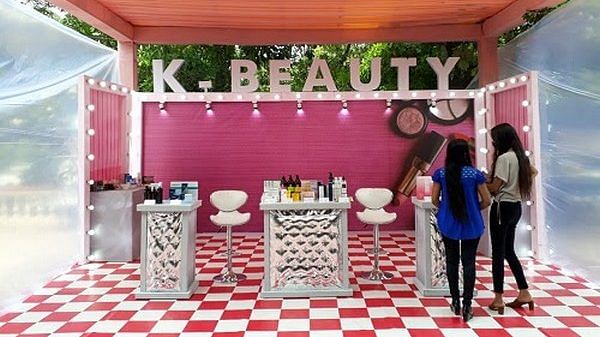If you are chasing that glass skin aesthetic, then this article is for you.
Thanks to this beauty trend, poreless, dewy skin has become the dream and the objective of our shelves, feeds, and faces.
But let me tell you something, with my 14+ years of experience in the skincare business: K-beauty could just be another fleeting trend for our skin.
Why? Read on to find out.
So, why are you seeing this trend everywhere?
With routines that involve a minimum of 10 steps — think snail serums, face masks, and sheet masks promising dewy-fresh skin — K-beauty has become the ultimate flex in the world of skincare. Stares pointedly at social media influencers.
Because yes — influencers, and social media in general, have played a huge role in pushing people to buy K-beauty products after watching a typical “#satisfying skincare ASMR” video featuring serums being used like they’re the skincare equivalent of the wheel.
Also read: Naga mom’s K-skincare wave swept India. Her Beauty Barn now competes with Nykaa, Amazon
What’s the logic behind K-beauty and its ingredients?
See, you’ve got to understand one thing: K-beauty isn’t only about aesthetics — it features some intensely innovative components too. Let me explain:
Snail mucin: Yes, I know it sounds gross, especially because mucin is a close cousin of mucus. And yes, literally — snail mucin is snail slime. As much as you might be shuddering, know this: it’s packed with hyaluronic acid and glycoproteins that hydrate your skin and kick dryness to the curb.
Centella Asiatica (Cica): This one’s the OG hero when it comes to soothing your skin. Ideal for red, itchy, and irritated skin, cica is like a chill pill for your face.
Fermented ingredients: Fermentation helps break down nutrients and makes them easier for your skin to absorb.
But here’s the catch — the point I keep repeating to all my patients — K-beauty and its products were designed for Korean skin tones and climates.
And us? Well, we’re built different.
One size clearly does not fit all
Genetics and melanin levels: While we’re prone to dark spots, tanning, and uneven skin tones, we have plenty of melanin to protect us. Korean skin types, on the other hand, typically have less melanin, making them more prone to hyperpigmentation.
Climate differences: Korea has cold winters and mild summers, so their skincare routines are geared toward locking in moisture with thick creams.
Now step outside where you are — you’ll be greeted by humidity, pollution, and the general feeling of your skin being a melting popsicle. If you still want to slather on 10 thick K-beauty products in that weather, be ready for clogged pores and acne.
Diet: Koreans eat a lot of kimchi, fresh vegetables, and seaweed-based foods — all great for the skin. We, on the other hand, indulge in spicy, greasy, and fried delights. No regrets, of course. But our diet does show up on our skin in different ways.
Also read:Indians have a new K in their lives. Not Karan Johar, Ekta Kapoor but Korean culture factory
So, is it worth it for us?
Look, I’m not asking you to swear off all K-beauty products. Some of them can work wonders — if you’re smart about it.
Say YES to:
- Lightweight hydrating agents: Hyaluronic acid-based serums, gel moisturisers — great for our weather.
- Sheet masks: Perfect for the occasional hydration boost.
- Gentle cleansers and toners: Always consult your trusted dermatologist to ensure your products aren’t stripping your skin of essentials.
Say NO to:
- 10-step, 15-step, or 20-step routines in our always-humid weather.
- Heavy creams in summer — unless you want acne as your new roommate for two weeks.
- Blindly following the “latest” trends without tailoring them to your skin type.
So, what should your skincare look like?
Back to basics:
- Gentle cleanser
- Light serum or aloe vera gel for hydration
- Sunscreen — non-negotiable.
Always pick mineral-based sunscreens over chemical ones. Look for MVP ingredients like zinc oxide and choose sunscreens with the triple “+” for better UVA/UVB protection.
Get 10–15 minutes of morning sunlight for a vitamin D boost — then apply your sunscreen.
Ingredients that work for our skin
- Niacinamide: Helps fade dark spots
- Vitamin C: Great skin brightener (if that’s your goal)
- Aloe vera: Soothes irritated skin
- Nuskhas (to an extent): Our older generation knows their stuff — sometimes a turmeric-honey-yogurt mask can do more than an expensive product.
Lifestyle tips: Sleep. Hydrate. De-stress. Repeat.
So, will K-beauty last?
Honestly, K-beauty is definitely a trend — but there are parts of it, like hydration-heavy products, that will benefit us long-term.
But at the end of the day, skincare isn’t about trends. It’s about what actually works for you.
So, tweak your K-beauty routine to suit our environment and skin types — and you just might have yourself a skincare win.
Dr Deepali Bhardwaj is a Consultant Dermatologist, Max Hospital, Saket. She is also an anti-allergy specialist, laser surgeon, and internationally trained aesthetician. She tweets @dermatdoc. Views are personal.
(Edited by Prashant)







Awesome.. congratulations 👏
Gives third dimension to the ongoing trend fir Korean products